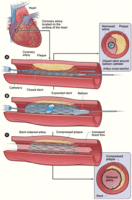
Photo from wikipedia
Purpose: To investigate the efficacy and sustainability of drug-coated balloon (DCB) treatment of femoropopliteal in-stent restenosis (ISR). Materials and Methods: An investigator-initiated, prospective, multicenter, 1:1 randomized study enrolled 88 patients… Click to show full abstract
Purpose: To investigate the efficacy and sustainability of drug-coated balloon (DCB) treatment of femoropopliteal in-stent restenosis (ISR). Materials and Methods: An investigator-initiated, prospective, multicenter, 1:1 randomized study enrolled 88 patients for treatment of ISR with DCB (n=47; mean age 68.3±9.6 years; 26 men) or uncoated balloon (n=41; mean age 67.6±10.2 years; 26 men) angioplasty (ClinicalTrials.gov identifier NCT01594684). Additionally, the protocol provided for an observational arm composed of patients from either randomized arm who experienced recurrent ISR ≥30 days after the index treatment. Redo treatment consisted of 2 DCBs sequentially inflated at the same location (double dose therapy). The majority of patients (66, 78%) had Rutherford category 3 ischemia. The mean lesion length was 140 mm; a third (27, 31%) were total occlusions. The primary endpoint was angiographic late lumen loss (LLL) at 6 months evaluated by an independent core laboratory. Results: Twenty-two patients (7 DCB +15 uncoated) were treated for recurrence with fully overlapping double DCB angioplasty. Six-month LLL was lower after DCB (0.34±1.12 mm) treatment than after angioplasty with an uncoated balloon (1.58±1.10 mm, p<0.001). At the 12-month follow-up, target lesion revascularization (TLR) was performed in 18 (49%) of 37 patients in the uncoated group, 6 (14%) of 43 patients in the single-dose DCB group (p=0.001), and no patients from the recurrent ISR group. At ~2 years after treatment, a remarkable number (14/27, 52%) of TLRs were recorded in the single-dose DCB group. Conclusion: Treatment with DCBs resulted in significantly less 6-month LLL and fewer TLRs up to 24 months than treatment with uncoated balloons. The double dose for treating recurrent ISR did not cause recognizable adverse events or require TLR up to 24 months.
Journal Title: Journal of Endovascular Therapy
Year Published: 2020
Link to full text (if available)
Share on Social Media: Sign Up to like & get
recommendations!